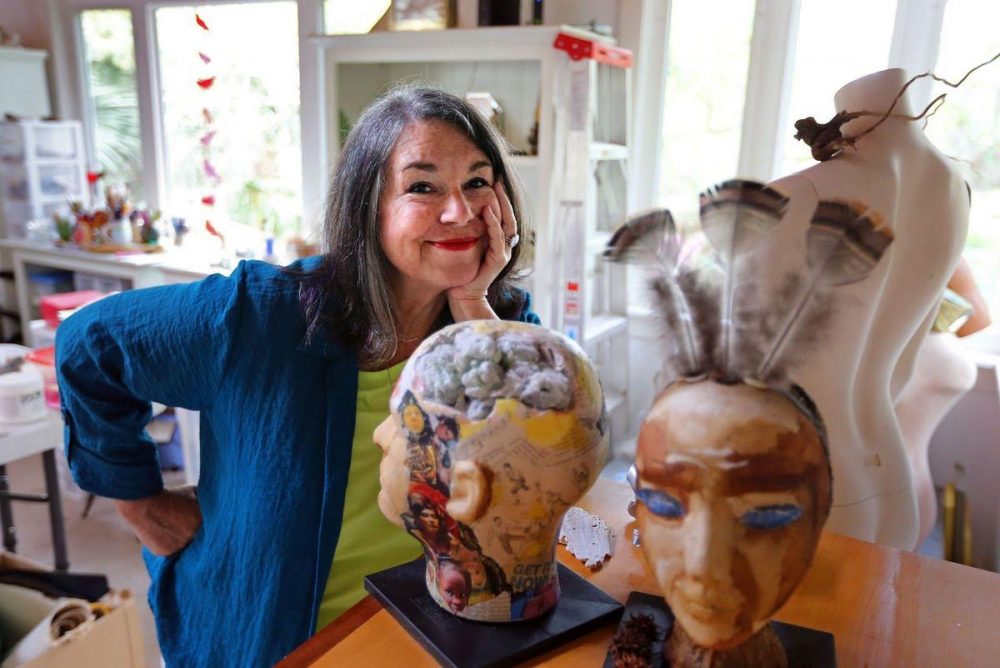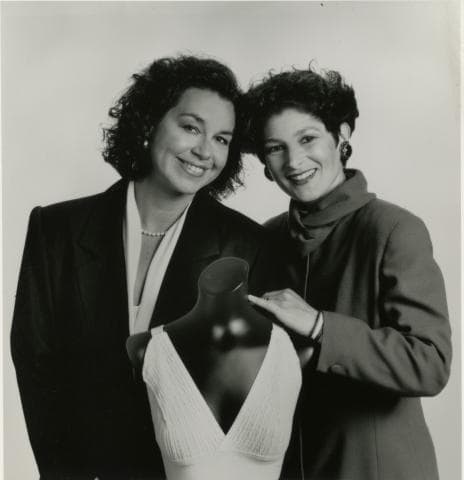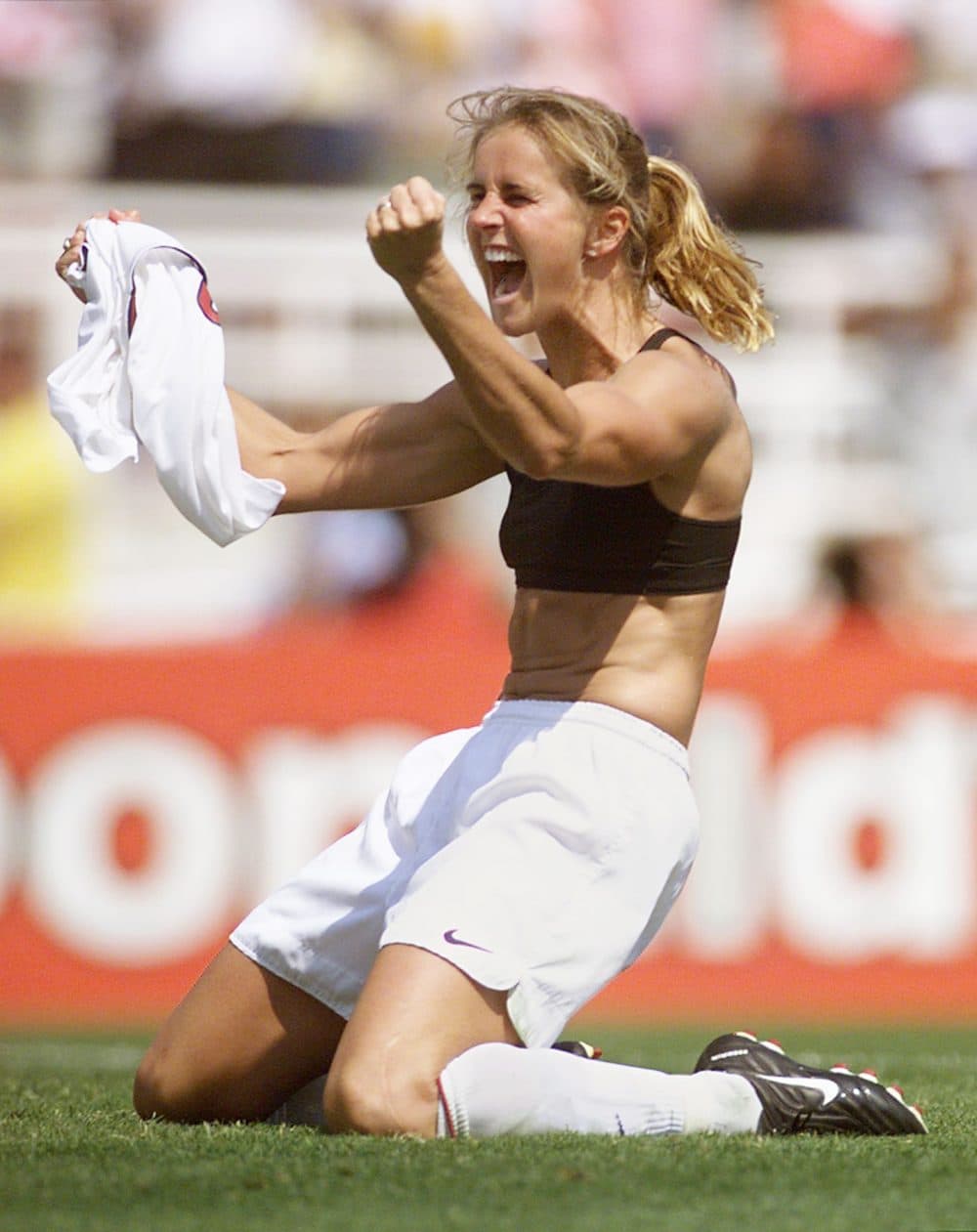Advertisement
From The 'Jockbra' To Brandi Chastain: The History Of The Sports Bra
Resume
We could fill an entire year’s worth of shows with stories about barriers to female participation in sports.
This is one of those stories.
But in this case it’s not a person, or even a group of people, standing in the way of women in sports. It’s a body part. Our champion in this fight is -- well, I’ll let her tell you who she is.
"I'm a human being and I try to live life beautifully," Lisa Lindahl says.
Lindahl has run a multinational corporation. She spent nine years on the board of the National Epilepsy Foundation. She’s worked with breast cancer survivors. And she’s just finished writing a book about “true beauty.”
"And yet what still captures the imagination is the sports bra," Lindahl says.
Yes, the sports bra. And I’ll just mention here that if you’re a person who is scandalized or offended by the fact that women have breasts, this might not be the story for you.
"It began when I was a little girl who liked to avoid gym class," Lindahl says.
Lindahl attended an all-girls school. It was the 1960s.
"In the locker room, you had to change into bloomers and little tunics, and then you had to put your clothes back on," Lindahl recalls. "You're all sweaty, and you had the same bra on."
Finding Love In Running
But later, married and living in Vermont, Lindahl was swept up in the running craze of the 1970s. She finally found something worth sweating for.
"Running for me became this joy," Lindahl says. "I grew up with epilepsy and I had seizures regularly. So I was not really ... friendly with my body so much until I started running. But there's one problem. My breasts were just uncomfortable."
Forty years ago, in the summer of 1977, Lindahl got a call from her sister. She had just started running too.
"And she said, 'OK, but what do you do for a bra? It's so uncomfortable,'" Lindahl recalls. "And I laughed and said, 'Yeah, I know it really is. It's just a terrible problem.' She said, 'You know, why isn't there a jockstrap for women?' And we just laughed uproariously. We thought that was so funny. When we hung up, I thought to myself, 'Hmm, that's not such a silly idea.'"
Lindahl sat down and started writing a wish list.
"The straps wouldn't fall. There wouldn't be any hardware to dig in. It couldn't chafe. It would be breathable and lightweight and all these wonderful things," she says.
But there was one more feature that Lindahl had on her mind. See, her regular running partner was a guy.
"And he would take off his shirt when we were running through the Vermont summer woods and tuck it in the back of his shorts. And I was always so jealous." Lindahl says. "Part of me wanted this new bra that — somehow — it would be modest enough for me to be able to do that. And I didn't really think it would be possible, but I hoped so."
Luckily, an old friend from that all girls school, Polly Smith, was renting a room from Lindahl and her husband while she worked on costumes for the Royall Tyler Theater in Burlington.
"So I went upstairs and I said, 'Polly, help me make this thing.' She rolled her eyes," Lindahl says.
Smith knew something Lindahl didn’t. Unlike other clothes, bras needed to be engineered.
"We would go up to the costume shop, and she would cut and sew something. And I'd go out running in it," she says. "And those early prototypes just were not cutting it."
An Idea Strikes
"I won't say it was a feminist attitude, but maybe. ... It wasn't about looking pretty. It was about function. Someone who was looking for function would go to a sporting goods store."
Lisa Lindahl
One day, Smith and Lindahl were sitting together on the living room floor when Lindahl's husband came walking down the stairs with his jockstrap pulled over his chest.
"[He was] saying, you know, 'Hey ladies, here's your jockbra. Ha ha ha,'" Lindahl recalls. "So I took it off of him and pulled it down over my own chest, because I had to be part of the funny, ha ha ha. And the minute I did it, I looked at Polly, and I said, 'You know what? This has potential.'"
The next day, Smith took two jockstraps and cut them apart. The cups became, well, cups. The leg straps were crossed over the back to become shoulder straps. The waistband became a rib band. It was the first modern sports bra.
"And when I went running in that it worked. So we deconstructed the jockstrap and recreated it as a jockbra," Lindahl says.
Smith took a trip to New York City to find nicer fabric and elastic. And Lindahl found a business partner to help fund the endeavor.

Lindahl's idea was working, but her marriage was not -- and that presented its own problems.
"I had been brought up to believe that I could not live alone — that if I were ever to have a seizure alone, I could die," Lindahl says. "So here I was, getting a divorce and facing living alone. I was in my late 20s. When I started, I didn't even have a driver’s license. I had to go cry at my neurologist and get a driver's license. When you ask me how all that was, it was frightening."
Lindahl decided the only thing to do was to keep moving forward. One of the first decisions she made about her new product -- she decided to call it the Jogbra — was that it didn’t belong in department stores.
"I won't say it was a feminist attitude, but ... maybe. That this was serious athletic equipment," Lindahl says. "This was not about lift and separate. It wasn't about looking pretty. It was about function. Someone who was looking for function would go to a sporting goods store.
"So here is the girl who skipped gym classes, walking into sporting goods stores to sell them a bra."
And as serious athletic equipment, the Jogbra wasn’t meant to be pretty. It was big and white and made of elastic.
Venturing West
Lindahl had this notion that all good sporting trends start in California, so she flew to San Francisco with a little briefcase full of samples. She hopped on a city bus and started looking for potential customers.
"And as the sporting goods store would go by, I'd hit the ding ding thing and get off the bus and walk back to the sporting goods store," she says. "When I got the right person, he — it was always a he — and he would say, 'A bra? Why would I put a bra in my sporting goods store?' And I would look at him and I'd say, 'You carry jockstraps, don't you?'"
The sales pitch worked. Lindahl's company was profitable in its first full year and grew in double digits every year after. But it wasn’t just gumption that made Lindahl's business grow. Those were the early days of Title IX — a federal law that guaranteed girls and women equality in education, including sports. More women playing sports meant that more women needed sports bras. And sports bras brought women who had stopped participating back to the courts, fields and running paths.
In 1984, a grad student named LaJean Lawson was awarded a research grant to study breast motion with the goal of learning how to build a better sports bra.
A watchdog group awarded her research a “Golden Fleece” award for worst misuse of state tax dollars.
Then, came the letters.
“If God had intended women to play sports,” one anonymous note said, “he wouldn’t have put breasts on their chests.”
There was something deeper going on. Because when Lisa Lindahl and LaJean Lawson were growing up, there was a sense that women were somehow too frail for vigorous exercise. Girls were forbidden from crossing the half court line while playing basketball and couldn’t run races longer than 400 meters. There was even literature suggesting too much exercise could damage women’s breasts and that bras could cause cancer.
But we can now prove that those ideas are bogus, in part because LaJean Lawson and other researchers came onto the scene to study how to build better sports bras. And while they were doing that, they also proved that sports bras aren’t needed to mitigate any potential damage to women’s bodies. They’re just about comfort.
The Defining Moment
"It was a wish and a hope and a desire. And there it was, right on, not just national TV, it was international. There are people all over the globe watching that."
Lisa Lindahl
In 1984, when Joan Benoit ran into the Los Angeles Colisuem to win the first women’s marathon in Olympic history, her bra strap was showing. Some people were scandalized. But over time, opinions changed.
Maybe you know where this is going.
In 1999, the U.S. played China in the Women’s World Cup in front of a sold out crowd at the Rose Bowl. The teams played to a tie. Brandi Chastain took the last penalty kick and scored.
By that time, Lisa Lindahl had sold her company -- it became Champion. But when Brandi Chastain ripped off her jersey – just like the men often do -- and swung it around in triumph, Lindahl was watching.

"It was a wish and a hope and a desire," Lindahl says. "And there it was, right on — not just national TV, it was international — there are people all over the globe watching that. When she's asked about that moment she talks about it being a long journey, You know, a long accumulation of effort and work, and that's what my life has been — it's like the two of us coming from two very different places, it all sort of came together in that moment of women's power and glory and truthfulness. And that was a moment of true beauty. Oh, by the way, thank you Brandi."
Just as the sports bra changed the sports culture, sports culture has come back to change the sports bra. Women don’t have to fight for their right to participate anymore. Nobody has to convince stores to carry sports bras. And sports bras no longer have to be these ugly, utilitarian, functional things. Women today can choose to be strong and beautiful.
"I mean, it gives me such a kick to walk into a department store and see a whole wall of sports bras," Lindahl says. "All different colors, some of them are very lacy, it's just amazing. And I think, 'Who would have thunk it?'"
It took both Title IX and the invention of the sports bra to make it possible for all women to participate in sports. Which wasn’t the goal of that newly divorced woman from Vermont who was just trying to figure out how to pay the bills.
"I never approached it with the idea of making the world a better place. So, what do I feel? I feel humbled and amazed. And proud — and amazed," she says laughing.
It might be a stretch to say that without the sports bra allowing more women to participate in sports, women might not have been hired as sports journalists, and I might never have gotten the chance to guest host a National Public Radio sports show from time to time.
But, maybe. So, thanks, Lisa.
This segment aired on February 25, 2017.
